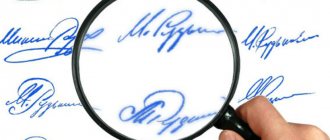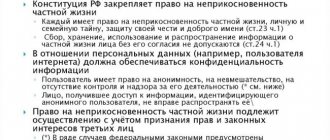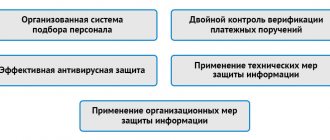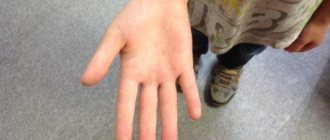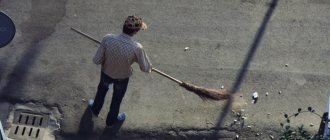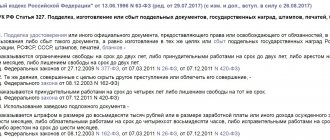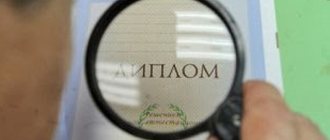Would you like to consult a lawyer for free? Write to the chat on the bottom right or call the hotline, calls within the Russian Federation are free. We accept questions any day of the week.
Forging signatures on documents is a criminal offense. The fact of its commission can be proven using graphological or technical-forensic examination. If the fact of forgery of a signature is established, the consequences of fulfilling the conditions of the forged document will be canceled. In addition, the citizen who resorted to forgery will be held accountable.
Corpus delicti
Forgery of a signature is equivalent to forgery of a document, since without the commission of illegal actions, a document with a forged signature could not come into force. Based on judicial practice, it can be determined that forgery of signatures in documents giving certain rights to the parties or imposing obligations on them is punishable. Forging a signature in a contract obliging the parties to comply with its terms, or in a statement depriving the applicant of some rights, will result in criminal prosecution.
But committing similar actions in a letter of gratitude or recommendations from an employer that do not affect the life of the one whose signature was forged will remain unpunished.
The liability will be the same regardless of how the forgery was carried out. If the offender tried to forge the victim’s signature on his own, a graphological examination will be carried out in order to prove this, if he used copying tools, a technical-forensic examination will be carried out.
Read more about how document falsification is carried out in our article.
Types of fakes
In the modern world, there are two types of signature forgery - manual and technical. Let's look at these issues in more detail, as there are a lot of subtleties.
Manual signature falsification
Due to the development of technology, it is becoming easier for modern criminals to commit crimes every day. Manual signatures are especially often forged, since the process does not require the use of specialized equipment. The manual method of forging a signature includes three types of falsification:
- The first method is the simplest and therefore known to everyone. This is a forgery of a handwritten signature. This requires some talent, because... This method involves restoring from memory or using the original manually. Almost everyone during their school days tried to forge teachers' signatures in their diaries. There are people who have developed this talent and use it illegally. It is usually easy to detect such fraud. As a last resort, an examination of the handwriting is carried out. The analysis requires an experienced professional, an original (usually 10 examples) and paper to be checked. In this case, documents where the signature was affixed with too much time difference are not subject to verification, because with age a person’s handwriting changes and it is more difficult to establish identity.
- The next method is one in which additional improvised means are used during counterfeiting. One of these tools is carbon paper, which is freely available in almost every office supply store. It is believed that such means allow one to achieve better quality during the falsification process.
- The third method involves the use of computer programs and a conventional laser printer. Scanned signatures are restored using a printer on paper. This type of counterfeit is more advanced and requires examination using modern equipment to identify the forgery.
Technical forgery of signature
Technical forgery of a signature is considered to be those methods of falsification that use computer technology, special equipment, or simply improvised means. The difference between a technical forgery and a manual one is that the forgery is not produced by handwriting, but by copying the signature from the original. The most commonly used types of technical counterfeiting are:
- Redrawing the signature in pencil and then tracing the strokes with ink. Typically, a soft pencil is used in this case. It is thanks to him that falsification is detected - coloring pigments remain on the paper.
- Imitation of a signature using special paper, exposed to light or by pressing, followed by tracing the contours with ink.
- A method of forging a signature using substances that have copying properties. In this case, various emulsions, films, photographic paper and even egg white can be used.
- Forgery using an electrographic apparatus. Today this is the most popular way to forge a signature. It is distinguished by the shine of the ink, the absence of relief and flaking of the dye.
- A less popular, but used method is falsification using printers. As a rule, in this case an inkjet or laser printer is used. Dot matrix printers are least suitable for these purposes. This type of forgery is also distinguished by its lack of relief; in addition, tiny drops of toner can be distinguished. It is easy to distinguish such a fake from the original - if water gets in, the outline of the signature will blur.
- Forgery using a printed form - facsimile. This method is the most difficult to determine, because... in this case, the fake will be most similar to the original. A distinctive feature will be the absence of grooves left by writing instruments.
Signs of forgery of a signature or parts of a document
In order to register the fact of signature forgery, it is necessary to identify the signs. They will differ for different methods of producing a forged document, but there are basic, common characteristics:
- The presence of paired lines, the sharpness of rounded strokes, traces of preparation. Such signs indicate that the signature was copied from the original.
- The presence of unnatural thickenings, blunt ends of lines, excessive tortuosity. These characteristics characterize the copying method of counterfeiting using glass.
- If you copy using special paper, the document will show pigment marks and poor line alignment. This sign is easy to detect - all you need is a magnifying glass and good lighting, or an infrared lamp.
- When falsifying a signature using materials with increased copying ability, emulsion particles can be found on the paper. There will also be no relief. Upon closer examination, you can see that the tinting of the signature is uneven, and small splashes of paint will be found next to the signature.
Features of bringing to responsibility
In order to bring the perpetrators to justice, it is necessary to have a falsified document and a professional expert’s opinion confirming the fact of forgery. It is necessary to have papers with a fictitious signature on hand, because they will serve as physical evidence. However, criminal prosecution for signature forgery has a number of features:
- Nowadays, no one will be surprised by forging the director’s signature at work. There are emergency moments in which the person committing this act does not have selfish goals. But in order to avoid punishment for forging a signature, it is still better to obtain written permission from management. If there is none, then an overly proactive employee may be fired for exceeding his authority.
- The situation is different - the employer falsifies the employee’s signature. Forging a signature on a payroll slip is the most common example. Thanks to such forgery, the entrepreneur may not pay the employee wages. If this fact is discovered, you must immediately file a claim in court.
- Forgery of signatures in sales contracts is also common today. If falsification is detected, such a document loses its validity, and the fraudster will be held responsible for forging the signature.
- Forging a signature in the minutes of a general meeting today also involves punishment, because For some time now, this document has been considered official. In this case, the most difficult thing will be to find the culprit of the forgery.
- Article 327 also provides for punishment for forging signatures on documents. The punishment in this case is determined by the court and depends on the severity of the crime.
- Forging a signature on the acceptance certificate may result in the contractor not receiving money for the work performed. In this case, a common mistake could have occurred - some employee signed the act for management. In any case, only examination and trial can help here.
- For violators, forging a signature in court may turn out to be a more serious crime than expected. The fact is that in this case Art. 303 also comes into force. The Criminal Code of the Russian Federation, which considers facts of falsification of evidence and the results of operational investigative activities.
Responsibility for forging a signature – article of the Criminal Code of the Russian Federation
Responsibility for forging a signature is provided for by 3 articles of the Criminal Code of the Russian Federation:
- Article 142 – for forgery in documents of an election campaign or referendum, committed by an organized group or using threats and bribery, or resulting in serious consequences (falsification of election or referendum results).
- Article 233 for forging a doctor’s signature on a prescription.
- Article 327 – signing for another person in a contract or other documents, or knowingly using forged documents. Covers a wide variety of types of documents that release or grant rights and obligations.
Here's the danger of forging a signature under Article 142:
- A fine of up to 500 thousand rubles, or in the amount of the convicted person’s income for 3 years.
- Deprivation of the right to hold any position for a period of up to 5 years.
- Up to 4 years of forced labor.
- Up to 4 years of freedom decision.
The court chooses one of the specified measures.
Article 233 provides:
- A fine of up to 80 thousand rubles, or in the amount of income for 6 months or less.
- Correctional labor for up to a year.
- Forced labor for up to 2 years.
- Imprisonment for up to 2 years.
Also, some form of punishment may be combined with deprivation of the right to engage in medical activities if the forgery was carried out by an official.
Liability is provided only if the forged prescriptions made it possible to purchase a psychotropic or narcotic substance.
According to Article 327 of the Criminal Code of the Russian Federation, criminal punishment for forging a signature (for individuals):
- For forgery - forced labor, restriction or imprisonment for up to two years.
- Forgery in order to facilitate the commission or concealment of another crime - forced labor or imprisonment for up to 4 years.
- For using a fake document - a fine of up to 80 thousand rubles, compulsory and corrective labor, or arrest. Punishment occurs only if the criminal deliberately used a forged document and desired the criminal consequences of its use.
How to prove a signature is fake?
There are two types of signature forgery: imitation and technical forgery. In the first case, a similar signature is depicted without preliminary preparation, in the second, technical methods are used. An examination must be appointed to determine whether it is a fake.
How does the examination take place?
An examination is appointed by a court decision in civil and arbitration proceedings, during the investigation of a criminal case, or on the initiative of one of the parties to a civil dispute. In addition, a handwriting examination may be ordered by the tax office during an on-site audit.
Experts may be asked various questions, including:
- whether the signature was forged;
- presumably by whom it was forged (age, gender, if a specific person is suspected, when compared, he can be identified as the author of the forgery);
- whether the signature is an auto-forgery, that is, it was made by a correct person, but with deliberate distortions.
Punishment under the Code of Administrative Offenses of the Russian Federation
Forgery of a signature is punishable under the Code of Administrative Offenses of the Russian Federation in two cases:
- If the offense is committed by a legal entity, since the organization cannot be held criminally liable. In this case, the court takes into account Article 19.23 of the Administrative Code, which provides for a fine of up to 40 thousand rubles and confiscation of property with which illegal actions were committed.
- If there is a forged signature in the documents of the election campaign, but this did not entail serious consequences and was not carried out using threats and bribery. Article 5.46 provides for liability in the form of a fine of up to 2.5 thousand rubles.
Administrative liability does not provide for other penalties.
In what cases can criminal liability be avoided?
In most cases, signature forgery is not subject to criminal prosecution. For liability to apply, the following conditions must be met:
- the document bearing the forged signature must be sold or used to obtain any form of benefit;
- there must be a selfish interest of the person who forged the signature.
- damage must be caused to the interests of third parties.
Based on these rules, most cases of signature forgery are not criminally punishable, therefore, a child who forged a parent’s signature in a diary and a secretary who endorsed a leave application instead of a manager will not bear any responsibility under the law.
Rules of law
More than one article of the Criminal Code relates to this act. Forgery of a signature is often considered as the final stage of a violation of the law in articles of the Criminal Code:
- 142 (falsification of election documents).
- 292 (official forgery).
- 292.1 (illegal issuance of a passport, i.e. acquisition of Russian citizenship).
- 322.2 (fictitious registration of a foreign citizen).
- 324 (purchase or sale of official documents).
- 325 (theft or damage to official documents).
- 327 (forgery or production, as well as sale of documents) and other similar provisions.
They forged a signature, where to go: what to do, help from a lawyer in the regions of the Russian Federation
- Altai (republic) Gorno-Altaisk
- Aleysk
- Belogorsk
- Arkhangelsk
- Astrakhan (Kirovsky district)
- Agidel
- Alekseevka (Alekseevsky district)
- Bryansk (Bezhitsky district)
- Babushkin (Kabansky district)
- Alexandrov (Alexandrovsky district)
- Volgograd (Voroshilovsky district)
- Babaevo (Babaevsky district)
- Bobrov (Bobrovsky district)
- Birobidzhan
- Baley (Baleysky district)
- Vichuga
- Angarsk
- Bagrationovsk (Bagrationovsky district)
- Gorodovikovsk (Gorodovikovsky district)
- Borovsk (Borovsky district)
- Vilyuchinsk
- Belomorsk (Belomorsky district)
- Anzhero-Sudzhensk
- Belaya Kholunitsa (Belokholunitsky district)
- Vorkuta
- Buoy
- Abinsk (Abinsky district)
- Achinsk
- Dalmatovo (Dalmatovo district)
- Dmitriev-Lgovsky (Dmitrievsky district)
- Boksitogorsk (Boksitogorsk district)
- Gryazi (Gryazinsky district)
- Magadan
- Volzhsk
- Ardatov (Ardatovsky district)
- Moscow (Akademicheskiy district)
- Aprelevka
- Apatity
- Naryan-Mar
- Arzamas
- Borovichi (Borovichi district)
- Barabinsk (Barabinsky district)
- Isilkul (Isilkul district)
- Abdulino
- Bolkhov (Bolkhovsky district)
- Belinsky (Belinsky district)
- Alexandrovsk (Alexandrovsky district)
- Arsenyev
- Velikie Luki
- Azov
- Zelenogorsk (Resort district)
- Aldan (Aldan ulus)
- Agryz (Agryz district)
- Kyzyl
- Abaza
To solve what problems is a signature examination carried out - 5 main tasks
Now let us turn our attention to the main tasks of signature research. There are more of them than might seem at first glance.
Task 1. Identifying the authorship of the signature
This is the first and main task of any signature examination.
If it is not possible to identify the author, the examination determines from the signature various signs characterizing his personality - character, temperament, gender, age, inclinations, etc.
This is determined by:
- signature size;
- length;
- type (roundness or angularity);
- tilt;
- underlining;
- legibility.
The publication “Authoristic Expertise” is about establishing data about the identity of the author of the text.
Task 2. Diagnosis of signature authenticity
Often, when investigating financial crimes, it is necessary to determine whether a specific person actually signed a document. Examination of the authenticity of a signature is also relevant in cases of falsification of accounting and tax documentation.
There are often cases when doubts arise about the authenticity of the signature on a will.
Example
Several years before his death, pensioner V.K. Smirnov drew up a will, according to which his property in the form of a three-room apartment was to go in equal parts to his two sons from his first marriage.
However, Smirnov’s second wife, with whom the civil marriage was not officially formalized, presented another will, according to which the husband assigned all the property to her. She claimed that her husband had drawn up this will shortly before his death.
How can we be here? Of course, take both wills and go to court with a request to order an examination of the signature.
This is a more complex study, since signature samples of a deceased person often turn out to be unsuitable for examination, or are not saved at all.
The features of this process are described in the article “Graphological examination”.
Task 3. Determining the conditions for writing a signature
Experts note that the signature is identified in any case, even if some interference was created during writing. The nature of the writing determines the conditions and state of the author in which he signed.
It could be:
- moving vehicles;
- Drunk;
- a state of partial loss of mobility due to injury or serious illness;
- severe cold that hinders movement;
- age-related changes;
- various factors that make writing difficult (uncomfortable posture, poor writing instrument or poor-quality surface on which the signature was written), etc.
Task 4. Revealing intent in changing the handwriting of a signature
You can distort a signature in a variety of ways. To do this, they imitate printed font, imitate the so-called student writing style (little developed), transfer the pen to the other hand, and sometimes even use their foot for this.
However, an experienced specialist will detect the forgery. It is impossible to distort a signature so much that it does not show the characteristic features of an individual hand.
On a similar topic, we suggest reading the publication “Technical and forensic examination of documents.”
Task 5. Establishing the signature completion date
It is also possible to check the signature for age. This is done in cases where it is necessary to establish the time of creation of a document or its falsification.
Most often, this need arises when dividing property or collecting a debt. However, statistics show that almost all criminal and civil cases cannot be completed without this type of signature research.
The less time has passed since the document was signed, the more accurate the examination of the signature’s prescription will be.
There are 3 methods used here:
- gas chromatographic (based on physical and chemical analysis);
- comparative (compares signatures during the period under study);
- traditional (in this case, the document is partially destroyed).
What is the state doing to protect electronic signatures?
As mentioned above, starting from 2022, the Federal Tax Service will take back the right to issue an electronic signature to the heads of commercial organizations. In this way, the tax service will form its own database of what it issued and to whom, and at the same time stop the flow of illegally issued electronic signatures for nominal managers.
There is still a lot of time until 2022, but you can protect yourself now.
Currently, the Federal Tax Service already allows an individual to issue an electronic signature through a personal account. Since you can register in your personal account only after a personal visit to the inspectorate, here, according to the Federal Tax Service, the likelihood of a data leak is minimal. Unless, of course, the individual himself gives access to an outsider.
It is also possible to obtain an electronic signature through the State Services website. You can apply for an electronic signature through the MFC with a passport and SNILS, the service is free. This signature allows access to the full list of services of the State Services portal.
In addition, the state regularly checks existing certification centers and closes those with violations. Control over CAs is constantly growing, requirements for them are increasing, in particular for the size of their authorized capital.
Who carries out the signature examination - review of the TOP-3 expert companies
Where can a signature be examined?
We'll give you a little hint.
1) Intersectoral Center for Forensic Expertise and Assessment
The organization is young, but actively developing. The management has assembled a good staff of experts with extensive experience in judicial and extrajudicial examination. There are specialists from various fields here.
If you need to appeal, you can order a review of the expert opinion. In the list of services offered you will also find damage, property and business assessments.
The center's expert opinions are recognized by arbitration courts, customs, tax authorities and other law enforcement agencies.
Leave a request on the website or call by phone, and your questions will be resolved as soon as possible.
2) Forensic
An experienced company, known throughout the country as a reputable institution with a professional approach to its business. Different types of examinations are carried out by highly qualified experts. Unique techniques and the most modern equipment allow us to increase the percentage of reliability of research to the maximum.
If you need an independent examination of a signature for a court, its price will not differ from similar services in other companies. You will get excellent quality by spending a minimum of money and time on research.
3) Consulting
Here you can order any independent examination - forensic, technical, transport, etc. If necessary, legal assistance is provided for individuals and legal entities.
In addition to expert services, the company provides:
- increasing the professional level of experts;
- verification of individuals and legal entities;
- certification of expert organizations and laboratories;
- arbitration proceedings.
The company is located in Moscow, but operates in all regions. Expert opinions issued by it are accepted by all courts of the Russian Federation.
What do attackers most often do?
The most common problems that scammers cause through electronic signatures are, in essence, seizing control of a company with further withdrawal of money from accounts.
This is done as follows. An electronic signature is made for a certain person, an application is submitted to the Federal Tax Service in form P14001 to change the general director of the company electronically, and after registering the changes in the Unified State Register of Legal Entities, they gain access to the bank and withdraw funds.
The tax office began to refuse all such attempts to change the director using an electronic signature. However, there is another way.
In this case, the directors are not changed, just a certain person issues an electronic signature for the director without his knowledge.
There are cases when adjustments to declarations were submitted electronically for a company, which led to problems with the tax office. This most often happens with VAT returns.
Or, as noted above, the attackers may be the company employees themselves, to whom the electronic signature was transferred from the director, and they abused his trust.
